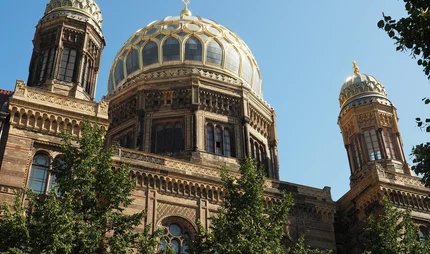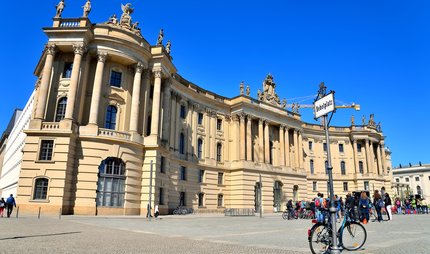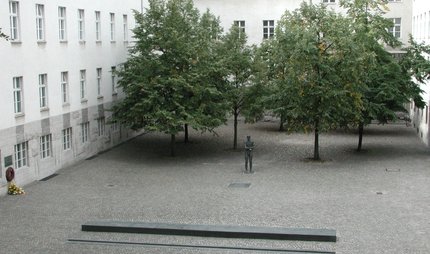
National Socialism and II. World War
Die NS-Regierung von 1933 - 1945 und der Zweite Weltkrieg
Assumption of power
The 30th January 1933, the “Day of the Takeover”, was celebrated by the Nazis with torch processions through the Brandenburg Gate. It did not take long before they began to deal with their political opponents by incarcerating then in the first concentration camps to be set up. Some 3,000 individuals, predominately left-wing supporters of the Weimar republic, were imprisoned, interrogated, tortured and compelled to perform manual labour in the Oranienburg concentration camp up to its dissolution in 1934. The emergency decree signed into law by Hindenburg following the Reichstag fire in February 1933 suspended the constitutional fundamental rights to personal freedom, as well as the freedom of opinion, association and assembly. As Head of the “Reich Commissariat for the Prussian Interior Ministry”, Hitler’s acolyte Hermann Göring ensured the de facto disempowerment of the Mayor of Berlin, Heinrich Sahm, by the appointment on 15th March 1933 of a “State Commissar for the Capital City of Berlin” to “assist” him. The passing of the “Ermächtigungsgesetz“ (Enabling Act) by the Reichstag on 23rd March 1933 finally opened the way for the Nazi dictatorship. On 1st April, the Berlin City Council met without the 44 Communist representatives, whose mandates had been cancelled by decree.
That day also witnessed the first boycotts of Jewish businesses, cafés, law firms and doctors’ practices, organised by the Nazis. SA units occupied the main building of the Berlin University, the State Library, institutes and clinics. On 10th May, a “fighting committee against the un-German spirit” joined together with students to burn books removed from a lending library on the square in front of the Old Library (today’s Bebelplatz). In 1934, the Berlin administration was “gleichgeschaltet” (brought into line), i.e. all elected bodies were dissolved in accordance with the “Law on the Constitution of the Capital Berlin” (15th July) and the Reich and provincial capital administered from now on “autonomously in compliance with the Führer principle”. On the death of Reich President Hindenburg on 2nd August 1934, an immediately issued decree declared Adolf Hitler as “Führer and Reich Chancellor” and “Supreme Commander” of the Wehrmacht (the Nazi successor to the Weimar Reichswehr).
1936 Olympic Games
During the Summer Olympic Games in Berlin from 1st to 16th August 1936, all anti-semitic signs were avoided. The German population was called upon to behave courteously and politely towards foreign guests. The “half-Jew” Theodor Lewald was allowed to become President of the Organising Committee and the “half-Jew” fencer Helene Mayer as well as the communist wrestlers were permitted to take part in the Games. At the same time, however, and unnoticed by the eyes of the world, the Nazis set up a labour camp for Roma and Sinti gypsies in the Berlin borough of Marzahn and Sachsenhausen concentration camp in Oranienburg.
700th Anniversary Celebrations in Berlin
The 700th anniversary of the founding of Berlin was used by the propaganda machine as an occasion to “force the history of the city into the National Socialist world view”*. Joseph Goebbels, Gauleiter (Party District leader) of Berlin and Reich Propaganda Minister, opened an outdoor show on the history of Berlin at the Funkturm, the population was entertained in their districts with public and sport festivals (such as the “Stralau Fischzug” (Fish Haul Ceremony) and a historical horse riding festival in Zehlendorf). These celebrations culminated in the festival “Berlin in Seven Hundred Years of German History” in the Olympic Stadium and a firework display on Königsplatz.
Reichspogromnacht
The anti-semitism manifested by the Nazis in an ever increasingly open manner culminated in the Reichspogromnacht of 9th November 1938. The assassination of a German embassy official in Paris by the disaffected Polish Jew Herschel Grynszpan provided the pretext for the destruction of Jewish department stores and businesses, apartments and synagogues not only in Berlin but in the whole of Germany (a day later in annexed Austria). The SA and SS burned down eleven of the fourteen synagogues in Berlin and badly damaged the other three. Over 1,000 Jews were arrested and deported to Sachsenhausen concentration camp (Oranienburg).
Second World War
In stark contrast to the First World War, The Second World War hit Berlin with the force of a tornado. Up to the capitulation of the Third Reich on 8th/9th May 1945, Over 450,000 tons of bombs were dropped on Berlin in English and American bombing raids, resulting in the deaths of approx. 20,000 Berliners with over 1.5 million made homeless. In a speech in the Berlin Sportpalast on 18th February 1943, Reich Propaganda Minister Goebbels proclaimed “Total War” as a response to German military defeats on all fronts. In April 1945, decimated German battle groups as well as the “Volkssturm” (People’s Storm) – wretchedly trained and equipped boys and old men – desperately engaged in bitter and hopeless street-to-street fighting against the overwhelming power of the Red Army in a one-month long bloody “Battle of Berlin” (April 1945). By the end of the war, half of the centre of Berlin lay in ruins and the population of the city had been reduced from 4.3 to 2.8 million.
Wannsee Conference
The conference held on 20th January 1942 in a SS-commandeered villa in the Berlin district of Wannsee by high-ranking Nazi officials under the chairmanship of Reinhardt Heydrich, was intended to provide the organisation and coordination of the “Final Solution of the Jewish Problem”. The representatives of Reich ministries and Party offices came to an agreement on the timing and logistics for the deportation of European Jews to the occupied areas of Eastern Europe. The “House of the Wannsee Conference” is now a Holocaust memorial to serve as a reminder of the genocide planned at that place.
Attempt on Hitler’s life
Operation “Valkyrie”, the coup planned by the Wehrmacht to take power, miscarried as a result of the failure of the bomb plot on 20th July 1944 to assassinate Hitler. Colonel Graf von Stauffenberg and his closest conspirators were executed by firing squad the same evening in the Bendler Block (today Memorial of German Resistance in Stauffenbergstraße). The resulting wave of arrests, show trials and executions cost the lives of some two hundred persons involved either directly or indirectly in the coup. The executions of those condemned to death by Freisler’s People’s Court took place in Plötzensee prison, today’s Plötzensee Memorial (part of the German Resistance Memorial).
Capitulation
Both Soviet and Polish units took part in the “Battle of Berlin” from 21st April 1945. On 30th April Hitler committed suicide in the Führer Bunker. Goebbels, the new Reich Chancellor, followed him the next day after failing in frantic efforts to obtain a ceasefire from Stalin. By 1st May 1945 Berlin had fallen. One week later, General Wilhelm Keitel in his capacity as Chief of the German Armed Forces High Command signed the documents of capitulation for all German forces in the Soviet headquarters in Berlin-Karlshorst.



